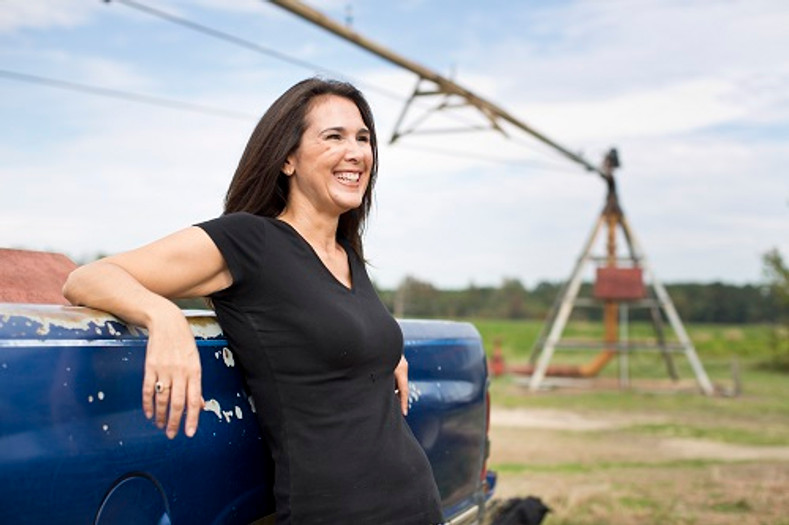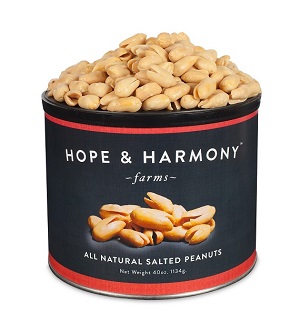SMALL TOWN GAL’S CONFESSION: How Virginia Peanuts Grow

I have a BIG confession to make. OK, get your mind out of the gutter. When I met farmer Pope back in the early nineties, I did not know how peanuts grew. GASP!! I know, I know! How dense can you be? Well give me a break, I was only nineteen and how different types of food grew was the LAST thing on my mind. So, fast forward to 2017 and now I am an expert. OK, I use that word loosely. Very loosely. I do not want to be arrested by the peanut police.
Most people are surprised to learn that peanuts do not grow on trees like pecans, cashews or walnuts. Peanuts are legumes, not tree nuts. They actually grow in the ground. So why have “nut” in the name? Confusing, I know. We will just blame that on some man hundreds of years ago. What the heck is a legume, anyway? Good question, a legume is simply a dry fruit contained within a shed, pod or shell. At Hope & Harmony Farms we grow only the Virginia variety peanuts. Now, let me stop here and explain. Virginia peanuts are an actual variety of peanut. They are not called Virginia peanuts just because they are grown in Virginia. Confusing, I know. There are 4 varieties of peanuts (1) Virginia, (2) Runners, (3) Spanish, (4) Valencia. You see Virginia peanuts are like the Rolls-Royce of peanuts. Virginia peanuts are the largest variety of peanuts grown in the world. Their impressive size, crunchy texture, outstanding peanut flavor and high nutritional value are what make these peanuts a “must have” for the peanut “snob”. You see, because these are such special nuts we treat them as such by cooking them by hand in small batches. Now that I have brought you up to speed on the types of peanuts, let’s get back to how peanuts grow.
The first seeds are planted after the last frost. Which for us in the big town of Drewryville is usually late April early May, when soil temperatures reach a balmy 65°—70°F. We plant specially grown and treated peanut kernels from the previous year’s crop about two inches deep, approximately one to two inches apart in rows. A lot of work goes into the land prior to planting. We till and bed the soil to ensure a rich, well-prepared seedbed. Well, let’s be honest here. I use “we” loosely. For those of you that read my first blog, remember the butter bean fiasco, farmer Pope does all of the tilling and bedding. I only visit the fields, ride along and offer encouragement. Looks good honey! Great job! You want to see a p!$t off farmer? Create a crooked peanut row. The peanut row must be perfectly straight!! This is NOT open for discussion. I was fired from planting and harvesting over 23 years ago and I am very, very thankful. My talents are elsewhere. Let me get back on track. For a good crop, 120 to 140 frost free days are required. Approximately 10 days after planting it really starts to get exciting. The peanuts seedlings rise out of the ground and grow into a green oval leafed plant about 18 to 20 inches tall. The peanut plant will flower above ground, but fruits below ground. So here is the cool part. Every flower represents a peanut below ground.

How cool is that?? So, imagine how excited farmer Pope gets when we see a field full of yellow flowers. These beautiful yellow flowers begin to emerge about 40 days after planting. These flowers will then pollinate themselves and the petals will fall off as the peanut ovary or peg begins to form. This process is called pegging. This is a unique process to the peanut plant. The peg enlarges and grows down and away from the plant forming a small stem which extends to the soil. The peanut embryo is in the tip of the peg, which penetrates the soil. The embryo turns horizontal to the soil surface and begins to mature taking the form of a peanut. The peanut plant continues to grow and flower, eventually producing some 50 or more pods. From planting to harvesting, it can take up to 5 months for the peanuts to mature. Peanuts are delicate in that watering is a must. Peanut plants need about 2 inches of water per week during kernel development. If the heavens do not meet our needs, we will irrigate our fields. Without sufficient rainfall, non-irrigated peanuts will begin to show drought stress. How about this cool fact? Peanuts are a nitrogen-fixing plant. Huh?? Its roots form nodules which absorb nitrogen from the air and provide enrichment and nutrition to the plant and soil. Cool, I know.
When the peanut plants are mature, the peanuts are ready for harvest. When conditions are right, Farmer Pope will drive a digger up and down the green rows of peanut plants. The digger has long blades that run four to six inches under the ground. The plant is loosened and the tap root is severed. Just behind the blade, the shaker will lift the plant from the soil and gently shake the dirt from the peanuts, rotates the peanut plant and lays the plant back down with peanuts up and leaves down. These rows are called “windrows”. What is a “windrow”? A windrow is a row of peanuts laid out to dry in the wind and sun. Peanuts contain anywhere from 25 to 50 percent moisture when they are first dug and must be dried to 10 percent or less so they can be stored properly. We will leave the peanuts in windrows for three to five days to dry before being harvested.
Once the peanuts have dried in the fields, a combine separates the peanuts from the vines, placing the peanuts into a hopper on the top of the machine and dropping the vines back in the field. Freshly dug peanuts are then placed into peanut trailers for further drying with forced warm air circulating through the trailer. In this final stage, the moisture content is reduced to 10 percent for storage. Peanuts are then graded by USDA inspectors and once we get the “all clear” the peanuts are shelled, blanched and then the magic happens. They arrive in my peanut kitchen where they are hand roasted, seasoned and shipped directly to you my friends!
Happy eating from this small-town gal, who went smaller and got big! Country girls do survive! #smalltowngalconfession
HOPE & HARMONY 40 OZ. SALTED VIRGINIA PEANUTS
Happy eating from this small town gal, who went smaller and got big! Country girls do survive! #smalltowngalconfession
All the best,
Stephanie
Love the land • Respect your roots • Give your best
